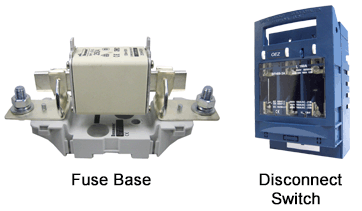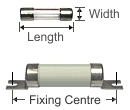Complete Guide to NH Fuses
What are NH Fuses?
NH fuses (also known as NH Knife Blade Fuses or DIN NH Blade Fuses) were defined in the German DIN standard 43620 around 1944. They were primarily designed as general purpose fuses for the protection of conductors. NH fuses are one-time fuses, meaning once they have blown, they must be replaced with a new fuse with the same characteristics.
NH Fuse Construction.
NH fuses are constructed from a rectangular ceramic casing enclosed by a cover plate that features a metal blade style terminal on each end. The fuse element inside the casing is connected to the cover plate / blade terminals. The majority of NH Fuses have a trip indicator to show if the fuse element has blown. Each cover plate includes a metal extraction lug that enables quick removal of the fuse from a holder when using the recomended NH fuse puller tool.
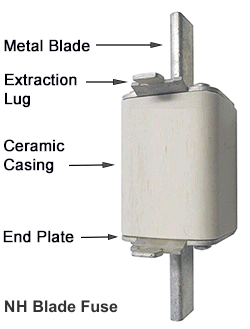
Where can I buy NH Fuses?
We stock a huge range of NH fuses to suit different applications.
Click on the application links below to see our product ranges.
You can purchase online or contact our friendly sales staff for assistance.
| Application | Type | NH Fuse Size | Voltage |
| General Purpose | gL / gG | 000 to 4a | 500VAC to 690VAC |
| Motor protection | aM | 000 to 4a | 500VAC to 690VAC |
| Semiconductor protection | aR / gR | 000 to 3 | 690VAC |
| Semiconductor protection | aR / gR | 00 to 0 | 1000VAC |
| Solar PV protection | gPV | 1 to 3 | 1000VDC |
| Battery protection | gS | 000 to 3 | 440VDC to 550VDC |
| Neutral Links | - | 00 to 4a | - |
NH Fuse Speeds.
NH Fuses have evolved over the years to suit a wide range of applications. Currently NH fuses are available in a wide range of element speeds. The element speed is usually printed on the fuse casing as one of the following markings;
| aR, gR | Protection of semiconductor devices, Very Fast Acting fuse. |
| gL, gG | General Purpose, Fast Acting fuse. |
| aM | Motor Protection, Slow Acting fuse. |
| gPV | Protection of solar photovoltaic arrays. |
| gS | Protection of Batteries. |
| View all element speeds |
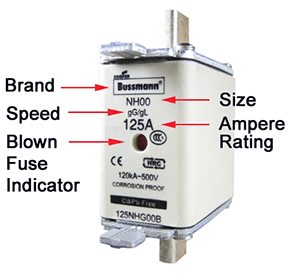
NH Fuse Sizes.
NH come in a variety of different sizes as you can see in the table below:
| Size | Body Type | Overall Length |
Body Length |
Body Width |
| NH 000 | Standard | 79 | 53 | 21 |
| NH 00C | Compact | 79 | 53 | 21 |
| NH 00 | Standard | 79 | 53 | 28 |
| NH 0 | Standard | 125 | 68 | 28 |
| NH 1C | Compact | 135 | 68 | 28 |
| NH 1 | Standard | 135 | 72 | 46 |
| NH 2C | Compact | 150 | 72 | 46 |
| NH 2 | Standard | 150 | 72 | 54 |
| NH 3C | Compact | 150 | 72 | 54 |
| NH 3 | Standard | 150 | 72 | 65 |
| NH 4 | Standard | 200 | 75 | 100 |
| NH 4a | Standard | 200 | 75 | 95 |
Dimensions (in mm) are based on ETI fuse range and may vary between brands.
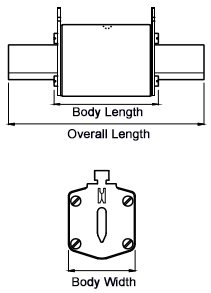
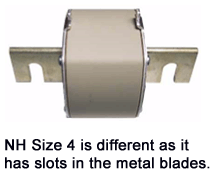
NH Fuse Extraction.
The safest and most simple way to remove an NH fuse from a holder is by using an NH Fuse Extractor. This tool ensures that you do not come into contact with any live parts. Without an extractor, NH fuses can be difficult to remove due to a tight fit between the clips of the holder and the metal fuse blades. Swe-Check sells an NH fuse extractor that is suitable for all removing all NH fuse sizes 000 to 4.
To remove a NH fuse using the extractor, you simply engage the fuse extractor onto the fuse extraction lugs, then pull the fuse out of the holder. When the fuse is removed, press the red button on top of the extractor and remove the fuse by sliding it off.
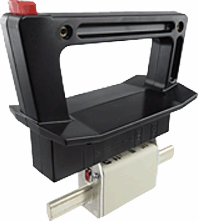
NH Fuse Holders.
There are 2 common types of NH fuse holder;
1. NH Fuse Base / NH Fuse Block.
2. NH Fuse Disconnect Switch.
Click here to learn more about NH fuse holders.
